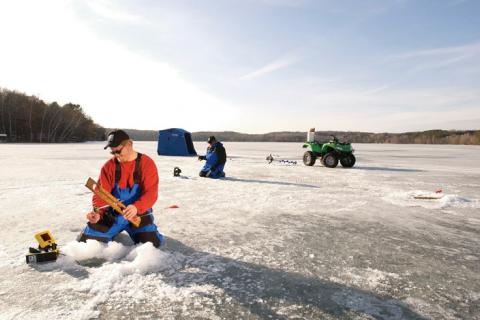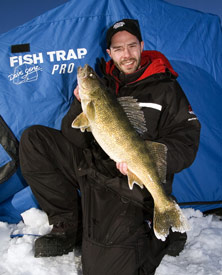
Ice fishing a new lake heightens the excitement and adventure of catching fish. It's fun to try new spots, and exploring new water increases your proficiency as a hard-water angler. To help you make the most of your ice-fishing adventures, here are some tips on how to approach a new lake.
 |
| Author Tim Allard displays a nice walleye he pulled through the ice. |
Do Your Fishing Homework
Do a bit of research to increase your chances of success before selecting a body of water. After deciding your target species, contact the department of natural resources for information. Tell them where you plan to fish and ask if they can provide data on lake populations, such as stocking or index netting reports. With this information you can short-list some water bodies to explore.
Next, you'll need a road map to plan your route to the lake and a hydrographic one to decide where to fish. Winter access varies from lake to lake, and a lot hinges on snow removal. For this reason, it's often best to set aside some time just to scout spots and investigate access options.
Tap Local Knowledge From a Tackle Shop or Fishing Outfitter
A phone call to a tackle shop or outfitter can provide local intelligence on a new lake. Keep questions general and don't get too specific. Some folks get nervous when unfamiliar anglers start probing about local lakes and where to fish, so respect their privacy. Asking what fish are in what lakes, local lures, public access options and ice conditions are all fair game though. If possible, stop into the shop and pick up live bait or lures for your outing as a way to demonstrate your thanks.
Assemble an Ice Fishing Team and Set a Strategy
From a safety perspective, don't ice fish new water alone. Another advantage to bringing other anglers along is you can work together, trying spots and different presentations until you find a fish-catching pattern. You'll also have plenty of minds working to solve the where-are-the-fish puzzle; in theory, this should reduce the time it takes the group to find fish. I find four to five individuals is the best number for one group. It lets you spread out, but you won't feel like you're crowding each other.
Pack the Right Fishing Gear
As you'll be fishing unknown territory, it's important you bring tools to help you learn and record data from your outing. A handheld GPS unit is excellent. It helps you navigate backroads as well as store fishing spots. Store where you access the lake as a waypoint in your unit. You might not think it when you set out, but getting lost can happen, especially if you fish into the night or a fog rolls in. Carry spare batteries as well.
Portable sonars and underwater cameras are also valuable. Cameras are excellent for pinpointing fish-holding cover and structures. A flasher, like a Vexilar, gives you accurate depth readings and displays when fish are in the area.
Regardless of whether you use a power or hand auger, keep blades sharp for quick cutting. At early ice, hand models can be just as effective and easier to carry, but once ice gets thick, power augers are worth their extra weight and bulk.
Carry all this gear in a portable shelter. Shelters will also keep you protected from winter's harsh elements. Flip-over styles let you go from fishing to moving in mere minutes.
Hit the Ice
Once you arrive at your location, plan a route for your first few moves and the structures you want to try and fish. The group will be organized and work together, but you'll also be more efficient with your moves. Leave some flexibility in your plan in case you need to change your strategy, but keep in mind your first goal is to search out fish.
Drilling Ice Holes
 |
| Match your hole drilling strategy to the type of structure you're fishing. |
There are different patterns for drilling holes to search an area when ice fishing. I like to match my approach with the type of structure I'm fishing. For points, I like a "V", a star-shape or a grid pattern. For bays and flats, I use a zigzag pattern or a line when I'm searching for structure and weeds. Once I find them, I'll customize the hole pattern for the area. If on a weed edge, I'll try and follow it and the hole pattern will likely resemble the contour of the weedline. Drilling holes shouldn't be random, especially when you're fishing a new lake and searching for fish.
Try Small and Large Moves
Small moves are the tweaking of your position on a piece of structure. They're five to 20 yard changes. Use them to pick apart the area you're fishing and to get a better position on your quarry. Over the course of the day, a series of small moves can add up to a significant amount of water covered.
Large moves are used to cover big distances. This is where ATVs or snowmobiles are handy. They reduce the time you spend moving, so you can invest more time in fishing. If you're on foot, large moves become tiring and time consuming. One alternative is using roads and finding additional access points to the lake; however, you're often limited to public access points.
Fishing Lures and Presentation
Use baits you're confident with while searching for fish on new water. Lures emitting flash and vibrations, like spoons and swimming baits, are excellent for attracting fish from a distance. Once you find fish, try and get them to hit the same bait using finesse moves. Downsize to smaller more subtle baits if you can't coax hits with larger lures. Try a couple finesse presentations, but don't fixate on fish that won't bite. Often it's better to move and try to find active fish than spend a lot of time with finicky fish. Sometimes, a few short moves will put you into biters, while some days are just tough bites. If after several moves, a lot of fish seem off, it may be better to stick it out and try and finesse fish.
This year, try and set a goal to ice fish a few new lakes. It can be intimidating at first, but in the long run you'll improve your skills as an angler. With each new lake you fish, you'll increase the ice fishing experience under your belt, not to mention getting to see another piece of the great outdoors.
|
Ice Fishing Safety Safety should always be your number one priority when ice fishing new water. Springs, inlet creeks and current areas all impact the thickness of the ice, so regularly check the depth of ice when moving. Use an auger, chisel or spud to cut through the ice. Don't walk on anything less than four inches of solid, clear ice. Also wear flotation clothing, such as a marine anti-exposure work suits or a PFD over your clothing in case you fall in. Carry a throw rope and a first-aid kit. Pack an extra set of clothes to leave in the car, bring a cell phone and always leave an itinerary at home when fishing a new lake. |
- 7493 views

